Exploring Impact of Surrounding Service Facilities on Urban Vibrancy Using Tencent Location-Aware Data: A Case of Guangzhou
Abstract
1. Introduction
2. Literature Review
2.1. Urban Vibrancy
2.2. Land Use and Urban Vibrancy
3. Study Area and Data
3.1. Study Area
3.2. Data Collection
4. Methodology
4.1. Geographically and Temporally Weighted Regression
4.2. Explanatory Variables
5. Results
5.1. The Spatial Distribution of Vibrancy
5.2. Overall Impact Mechanism of Service Facilities and Vibrancy
5.3. Spatiotemporally Varying Impact of Service Facilities on Vibrancy
- (1)
- Purely temporal variations in the impact of service facilities on urban vibrancy
- (2)
- Spatiotemporal variations in the impact of service facilities on urban vibrancy
6. Discussion
7. Conclusions
Author Contributions
Funding
Institutional Review Board Statement
Informed Consent Statement
Data Availability Statement
Acknowledgments
Conflicts of Interest
References
- Montgomery, J. Making a city: Urbanity, vitality and urban design. J. Urban Des. 1998, 3, 93–116. [Google Scholar] [CrossRef]
- Jin, X.; Long, Y.; Sun, W.; Lu, Y.; Yang, X.; Tang, J. Evaluating cities’ vitality and identifying ghost cities in China with emerging geographical data. Cities 2017, 63, 98–109. [Google Scholar] [CrossRef]
- Lu, S.; Shi, C.; Yang, X. Impacts of Built Environment on Urban Vitality: Regression Analyses of Beijing and Chengdu, China. Int. J. Environ. Res. Public Health 2019, 16, 4592. [Google Scholar] [CrossRef] [PubMed]
- Wu, C.; Ye, X.; Ren, F.; Du, Q. Check-in behaviour and spatio-temporal vibrancy: An exploratory analysis in Shenzhen, China. Cities 2018, 77, 104–116. [Google Scholar] [CrossRef]
- Lynch, K. Good City Form; MIT Press: Cambridge, MA, USA, 1984. [Google Scholar]
- Xia, C.; Yeh, A.G.-O.; Zhang, A. Analyzing spatial relationships between urban land use intensity and urban vitality at street block level: A case study of five Chinese megacities. Landsc. Urban Plan. 2020, 193, 103669. [Google Scholar] [CrossRef]
- Zhang, X.; Sun, Y.; Zheng, A.; Wang, Y. A New Approach to Refining Land Use Types: Predicting Point-of-Interest Categories Using Weibo Check-in Data. ISPRS Int. J. Geo-Inf. 2020, 9, 124. [Google Scholar] [CrossRef]
- Long, Y.; Liu, X. Featured Graphic. How Mixed is Beijing, China? A Visual Exploration of Mixed Land Use. Environ. Plan. A Econ. Space 2013, 45, 2797–2798. [Google Scholar] [CrossRef]
- Sun, Y.; Fan, H.; Li, M.; Zipf, A. Identifying the city center using human travel flows generated from location-based social networking data. Environ. Plan. B Plan. Des. 2015, 43, 480–498. [Google Scholar] [CrossRef]
- Vu, H.Q.; Li, G.; Law, R.; Ye, B.H. Exploring the travel behaviors of inbound tourists to Hong Kong using geotagged photos. Tour. Manag. 2015, 46, 222–232. [Google Scholar] [CrossRef]
- Sun, Y.; Fan, H.; Bakillah, M.; Zipf, A. Road-based travel recommendation using geo-tagged images. Comput. Environ. Urban Syst. 2015, 53, 110–122. [Google Scholar] [CrossRef]
- Yang, D.; Zhang, D.; Zheng, V.W.; Yu, Z. Modeling User Activity Preference by Leveraging User Spatial Temporal Characteristics in LBSNs. IEEE Trans. Syst. Man Cybern. Syst. 2015, 45, 129–142. [Google Scholar] [CrossRef]
- Liu, X.; He, J.; Yao, Y.; Zhang, J.; Liang, H.; Wang, H.; Hong, Y. Classifying urban land use by integrating remote sensing and social media data. Int. J. Geogr. Inf. Sci. 2017, 31, 1675–1696. [Google Scholar] [CrossRef]
- Tang, L.; Lin, Y.; Li, S.; Li, S.; Li, J.; Ren, F.; Wu, C. Exploring the Influence of Urban Form on Urban Vibrancy in Shenzhen Based on Mobile Phone Data. Sustainability 2018, 10, 4565. [Google Scholar] [CrossRef]
- Jia, C.; Du, Y.; Wang, S.; Bai, T.; Fei, T. Measuring the vibrancy of urban neighborhoods using mobile phone data with an improved PageRank algorithm. Trans. GIS 2019, 23, 241–258. [Google Scholar] [CrossRef]
- Ye, Y.; Li, D.; Liu, X. How block density and typology affect urban vitality: An exploratory analysis in Shenzhen, China. Urban Geogr. 2018, 39, 631–652. [Google Scholar] [CrossRef]
- Mellander, C.; Lobo, J.; Stolarick, K.; Matheson, Z. Night-Time Light Data: A Good Proxy Measure for Economic Activity? PLoS ONE 2015, 10, e0139779. [Google Scholar] [CrossRef]
- Chen, T.; Hui, E.C.; Wu, J.; Lang, W.; Li, X. Identifying urban spatial structure and urban vibrancy in highly dense cities using georeferenced social media data. Habitat Int. 2019, 89, 102005. [Google Scholar] [CrossRef]
- Lu, S.; Huang, Y.; Shi, C.; Yang, X. Exploring the Associations Between Urban Form and Neighborhood Vibrancy: A Case Study of Chengdu, China. ISPRS Int. J. Geo-Inf. 2019, 8, 165. [Google Scholar] [CrossRef]
- Shaw, S.-L.; Tsou, M.-H.; Ye, X. Editorial: Human dynamics in the mobile and big data era. Int. J. Geogr. Inf. Sci. 2016, 30, 1687–1693. [Google Scholar] [CrossRef]
- Goodchild, M.F. Citizens as sensors: The world of volunteered geography. GeoJournal 2007, 69, 211–221. [Google Scholar] [CrossRef]
- He, Q.S.; He, W.S.; Song, Y.; Wu, J.Y.; Yin, C.H.; Mou, Y.C. The impact of urban growth patterns on urban vitality in newly built-up areas based on an association rules analysis using geographical “big data”. Land Use Policy 2018, 78, 726–738. [Google Scholar] [CrossRef]
- Li, M.; Sagl, G.; Mburu, L.W.; Fan, H. A contextualized and personalized model to predict user interest using location-based social networks. Comput. Environ. Urban Syst. 2016, 58, 97–106. [Google Scholar] [CrossRef]
- Anselin, L. Local Indicators of Spatial Association-LISA. Geogr. Anal. 1995, 27, 93–115. [Google Scholar] [CrossRef]
- Fotheringham, A.S.; Brunsdon, C.; Charlton, M. Geographically Weighted Regression: The Analysis of Spatially Varying Relationships; John Wiley & Sons: Hoboken, NJ, USA, 2003. [Google Scholar]
- Wu, L.; Zhi, Y.; Sui, Z.W.; Liu, Y. Intra-Urban Human Mobility and Activity Transition: Evidence from Social Media Check-In Data. PLoS ONE 2014, 9, 13. [Google Scholar] [CrossRef] [PubMed]
- Jacobs, J. The Death and Life of Great American Cities; Vintage: New York, NY, USA, 1961. [Google Scholar]
- Park, D.; Nakagawa, D.; Matsunaka, R.; Oba, T. Structural relationship about pedestrian vibrancy and street environment in central areas of Kyoto, Seoul, Beijing and Florence. Int. J. Urban Sci. 2012, 16, 187–202. [Google Scholar] [CrossRef]
- Meng, Y.; Xing, H. Exploring the relationship between landscape characteristics and urban vibrancy: A case study using morphology and review data. Cities 2019, 95, 102389. [Google Scholar] [CrossRef]
- Wu, J.; Ta, N.; Song, Y.; Lin, J.; Chai, Y. Urban form breeds neighborhood vibrancy: A case study using a GPS-based activity survey in suburban Beijing. Cities 2018, 74, 100–108. [Google Scholar] [CrossRef]
- Liu, Y.; Liu, X.; Gao, S.; Gong, L.; Kang, C.; Zhi, Y.; Chi, G.; Shi, L. Social Sensing: A New Approach to Understanding Our Socioeconomic Environments. Ann. Assoc. Am. Geogr. 2015, 105, 512–530. [Google Scholar] [CrossRef]
- Lamb, R.F. The Morphology and Vitality of Business Districts in Upstate New York Villages. Prof. Geogr. 1985, 37, 162–172. [Google Scholar] [CrossRef]
- Frank, L.D. Land Use and Transportation Interaction. J. Plan. Educ. Res. 2000, 20, 6–22. [Google Scholar] [CrossRef]
- Kenworthy, J.R.; Laube, F.B. Automobile dependence in cities: An international comparison of urban transport and land use patterns with implications for sustainability. Environ. Impact Assess. Rev. 1996, 16, 279–308. [Google Scholar] [CrossRef]
- Sharkova, I.V.; Sanchez, T.W. An Analysis of Neighborhood Vitality: The Role of Local Civic Organizations. Available online: https://pdxscholar.library.pdx.edu/cgi/viewcontent.cgi?article=1013&context=cus_pubs (accessed on 10 August 2016).
- Yue, Y.; Zhuang, Y.; Yeh, A.G.-O.; Xie, J.-Y.; Ma, C.-L.; Li, Q.-Q. Measurements of POI-based mixed use and their relationships with neighbourhood vibrancy. Int. J. Geogr. Inf. Sci. 2016, 31, 658–675. [Google Scholar] [CrossRef]
- Liu, Z.; Du, Y.; Yi, J.; Liang, F.; Ma, T.; Pei, T. Quantitative estimates of collective geo-tagged human activities in response to typhoon Hato using location-aware big data. Int. J. Digit. Earth 2020, 13, 1072–1092. [Google Scholar] [CrossRef]
- Liu, Z.; Du, Y.; Liang, F.; Ma, T.; Pei, T. Quantitative Association between Nighttime Lights and Geo-Tagged Human Activity Dynamics during Typhoon Mangkhut. Remote Sens. 2019, 11, 2091. [Google Scholar] [CrossRef]
- Zheng, S.; Zheng, J. Assessing the Completeness and Positional Accuracy of OpenStreetMap in China. In Thematic Cartography for the Society; Bandrova, T., Konecny, M., Zlatanova, S., Eds.; Springer International Publishing: Cham, Switzerland, 2014; pp. 171–189. [Google Scholar]
- Liu, Z.; Qian, J.; Du, Y.; Wang, N.; Yi, J.; Sun, Y.; Ma, T.; Pei, T.; Zhou, C. Multi-level Spatial Distribution Estimation Model of the Inter-regional Migrant Population Using Multi-source Spatio-temporal Big Data: A Case Study of Migrants from Wuhan during the Spread of COVID-19. J. Geo-Inf. Sci. 2020, 22, 147–160. [Google Scholar]
- Gong, P.; Chen, B.; Li, X.; Liu, H.; Wang, J.; Bai, Y.; Chen, J.; Chen, X.; Fang, L.; Feng, S.; et al. Mapping essential urban land use categories in China (EULUC-China): Preliminary results for 2018. Sci. Bull. 2020, 65, 182–187. [Google Scholar] [CrossRef]
- He, J.; Li, X.; Liu, P.; Wu, X.; Zhang, J.; Zhang, D.; Liu, X.; Yao, Y. Accurate Estimation of the Proportion of Mixed Land Use at the Street-Block Level by Integrating High Spatial Resolution Images and Geospatial Big Data. IEEE Trans. Geosci. Remote Sens. 2020, 10, 1–14. [Google Scholar] [CrossRef]
- Su, M.; Guo, R.; Chen, B.; Hong, W.; Wang, J.; Feng, Y.; Xu, B. Sampling Strategy for Detailed Urban Land Use Classification: A Systematic Analysis in Shenzhen. Remote Sens. 2020, 12, 1497. [Google Scholar] [CrossRef]
- Zong, L.; He, S.; Lian, J.; Bie, Q.; Wang, X.; Dong, J.; Xie, Y. Detailed Mapping of Urban Land Use Based on Multi-Source Data: A Case Study of Lanzhou. Remote Sens. 2020, 12, 1987. [Google Scholar] [CrossRef]
- Brunsdon, C.; Fotheringham, A.S.; Charlton, M.E. Geographically Weighted Regression: A Method for Exploring Spatial Nonstationarity. Geogr. Anal. 1996, 28, 281–298. [Google Scholar] [CrossRef]
- Huang, B.; Wu, B.; Barry, M. Geographically and temporally weighted regression for modeling spatio-temporal variation in house prices. Int. J. Geogr. Inf. Sci. 2010, 24, 383–401. [Google Scholar] [CrossRef]
- Guo, Y.; Tang, Q.; Gong, D.-Y.; Zhang, Z. Estimating ground-level PM2.5 concentrations in Beijing using a satellite-based geographically and temporally weighted regression model. Remote Sens. Environ. 2017, 198, 140–149. [Google Scholar] [CrossRef]
- Manaugh, K.; Kreider, T. What is mixed use? Presenting an interaction method for measuring land use mix. J. Transp. Land Use 2013, 6, 63–72. [Google Scholar] [CrossRef]
- Miles, R.; Song, Y. “Good” Neighborhoods in Portland, Oregon: Focus on Both Social and Physical Environments. J. Urban Aff. 2009, 31, 491–509. [Google Scholar] [CrossRef]
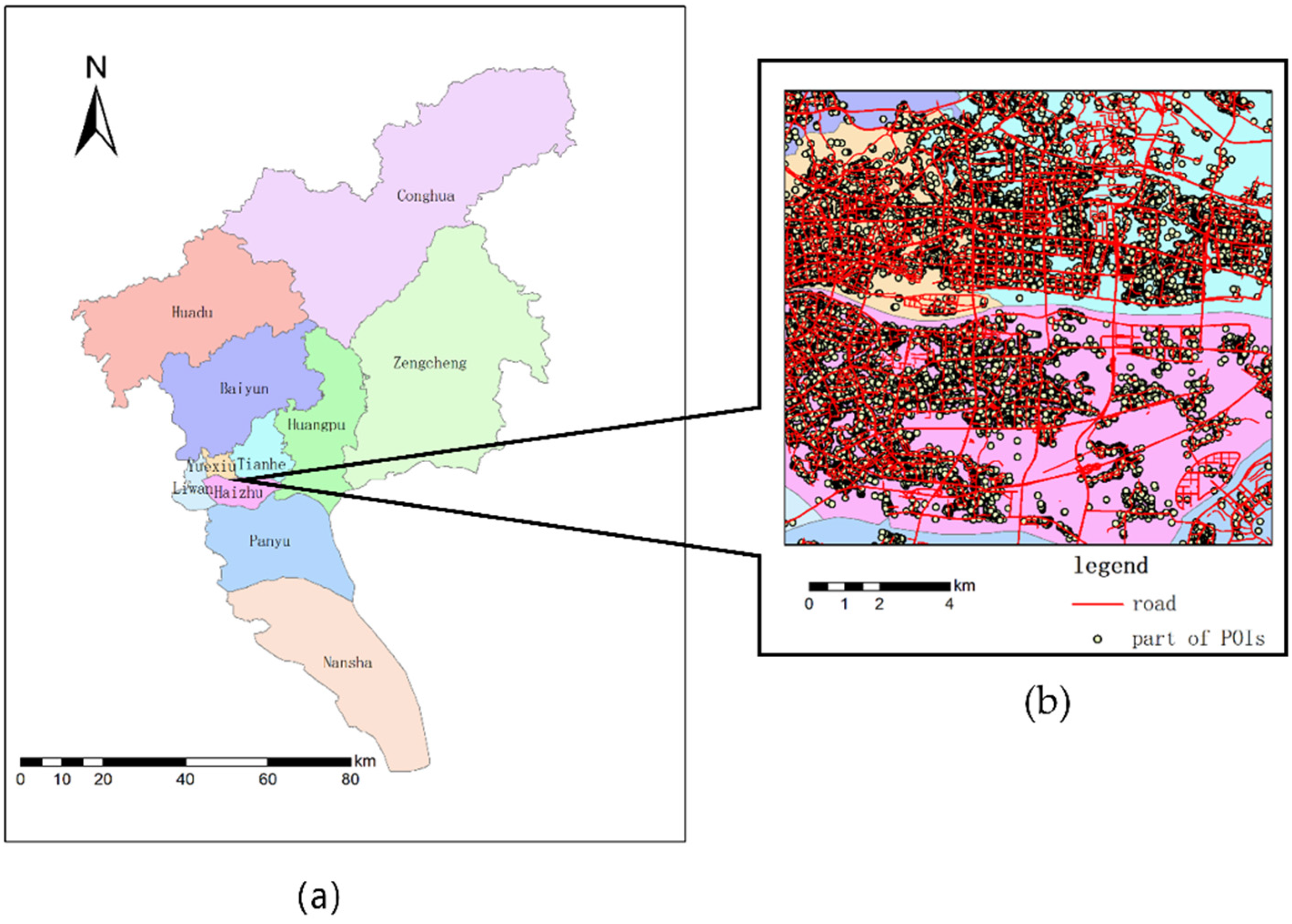
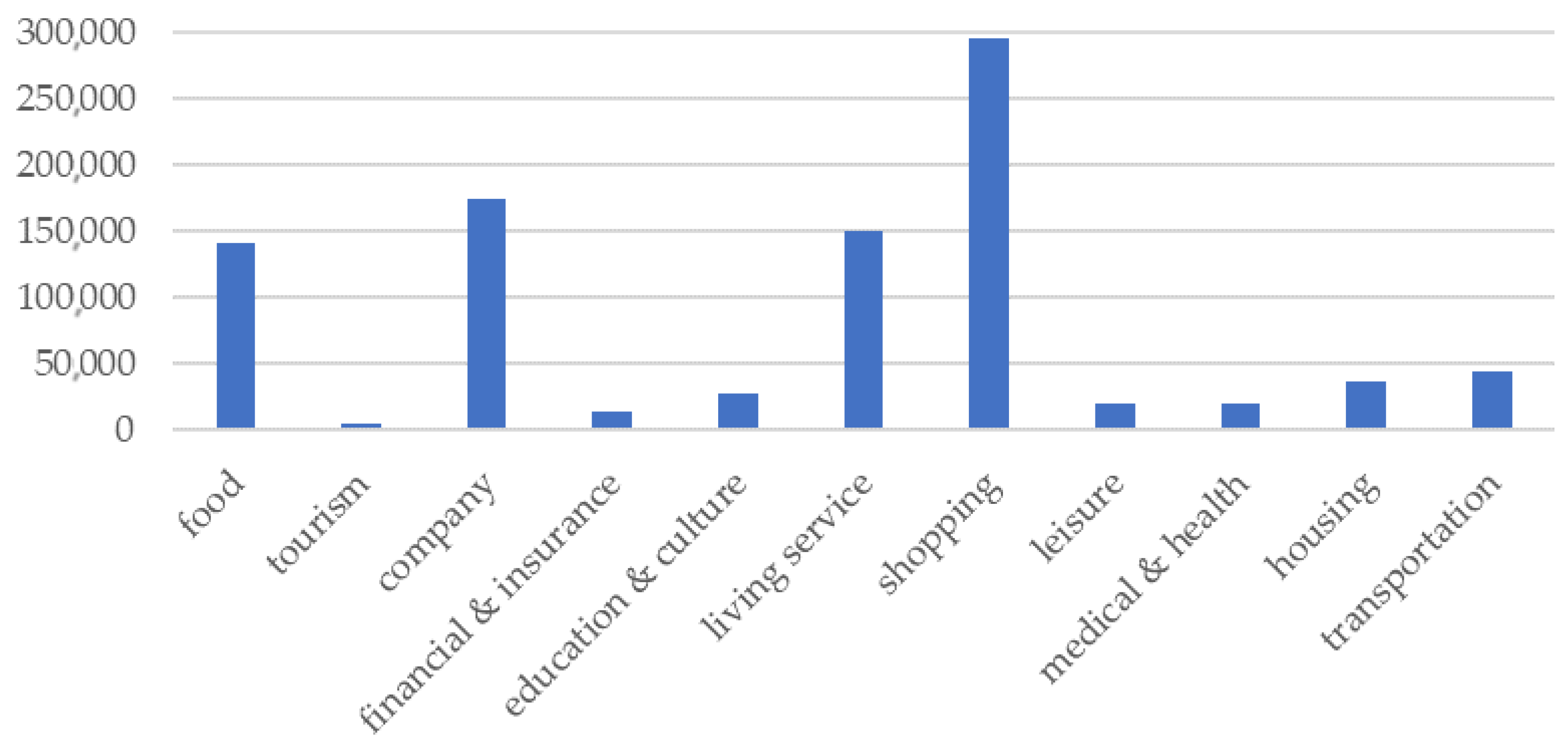
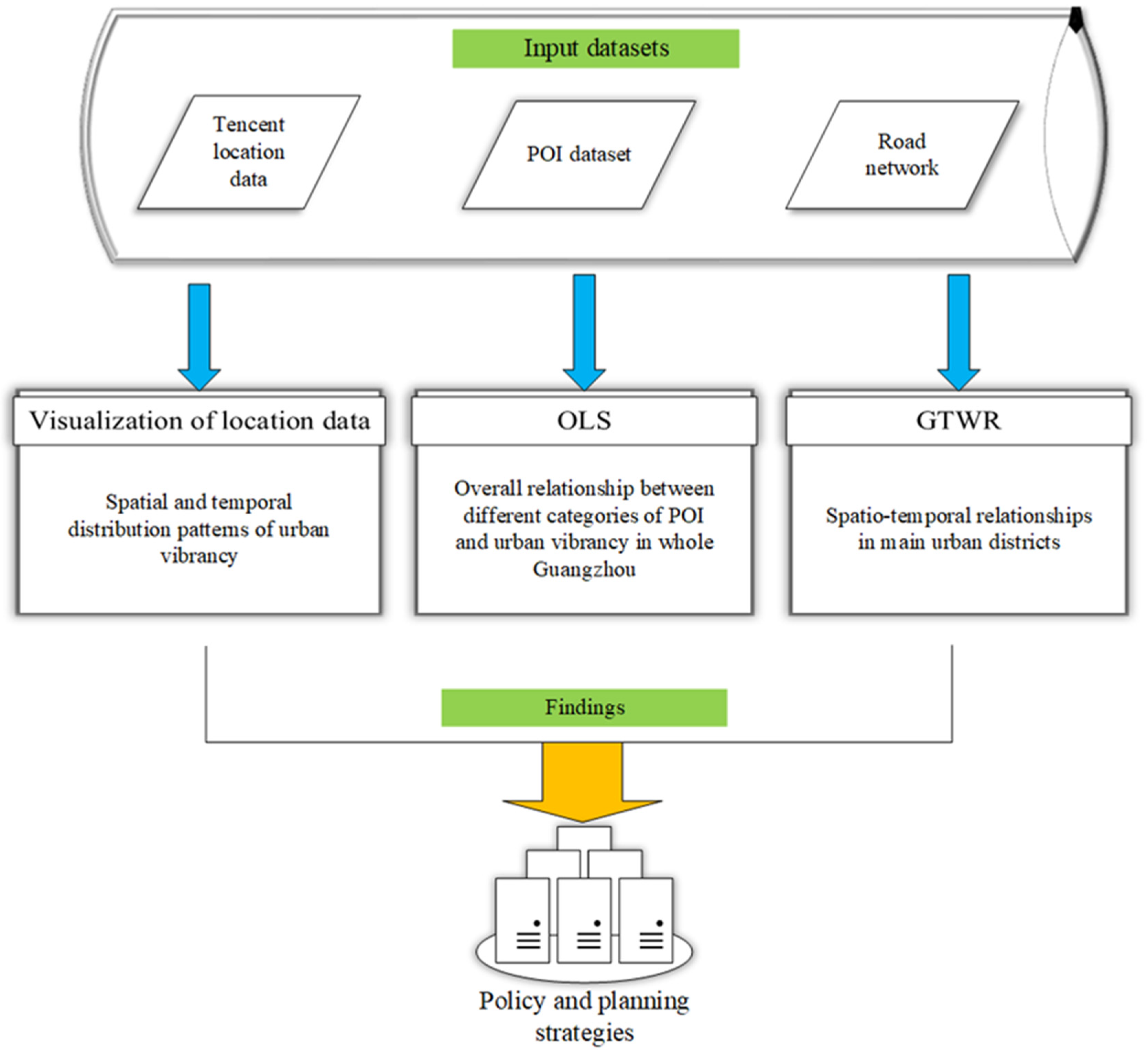
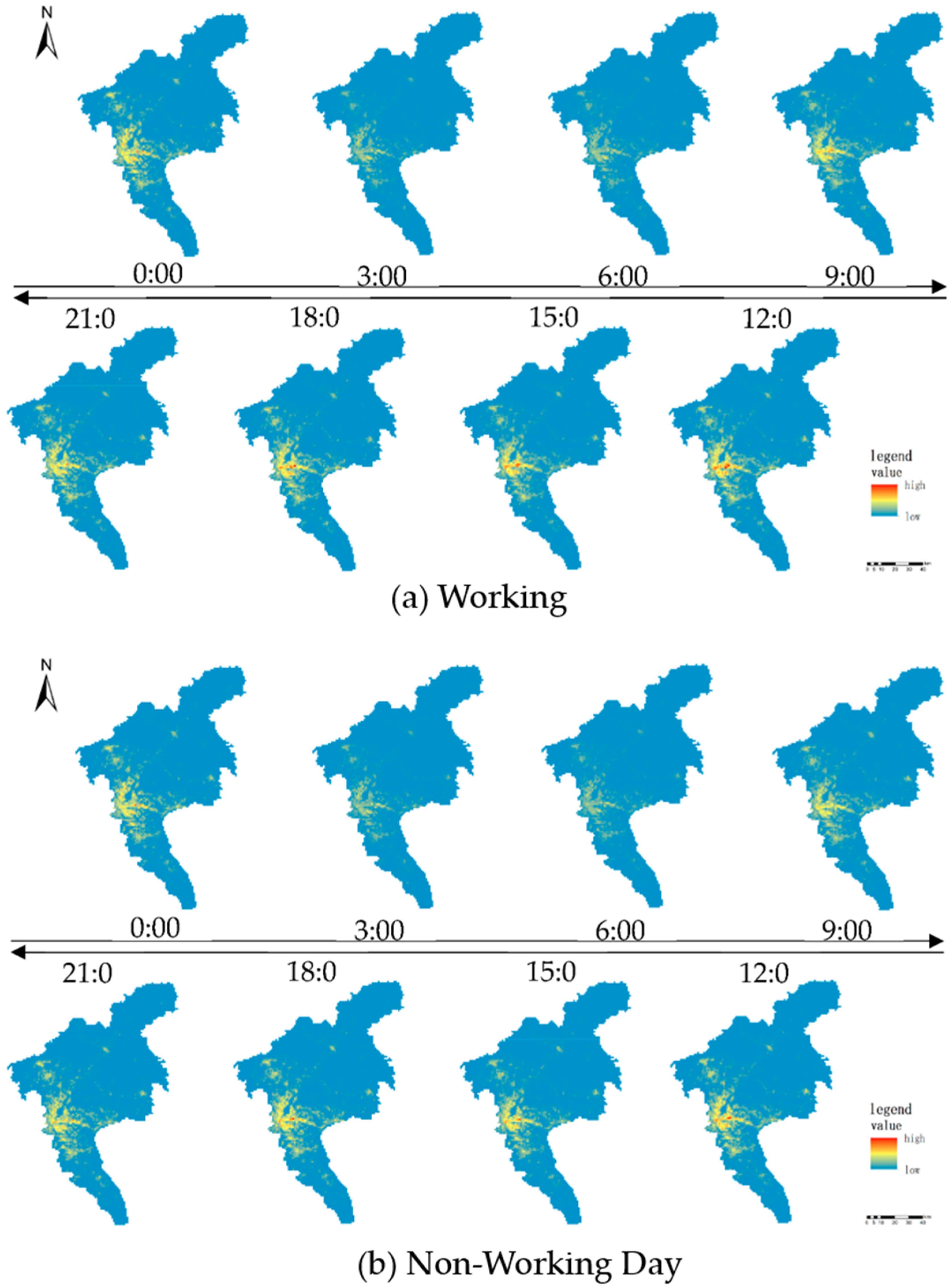
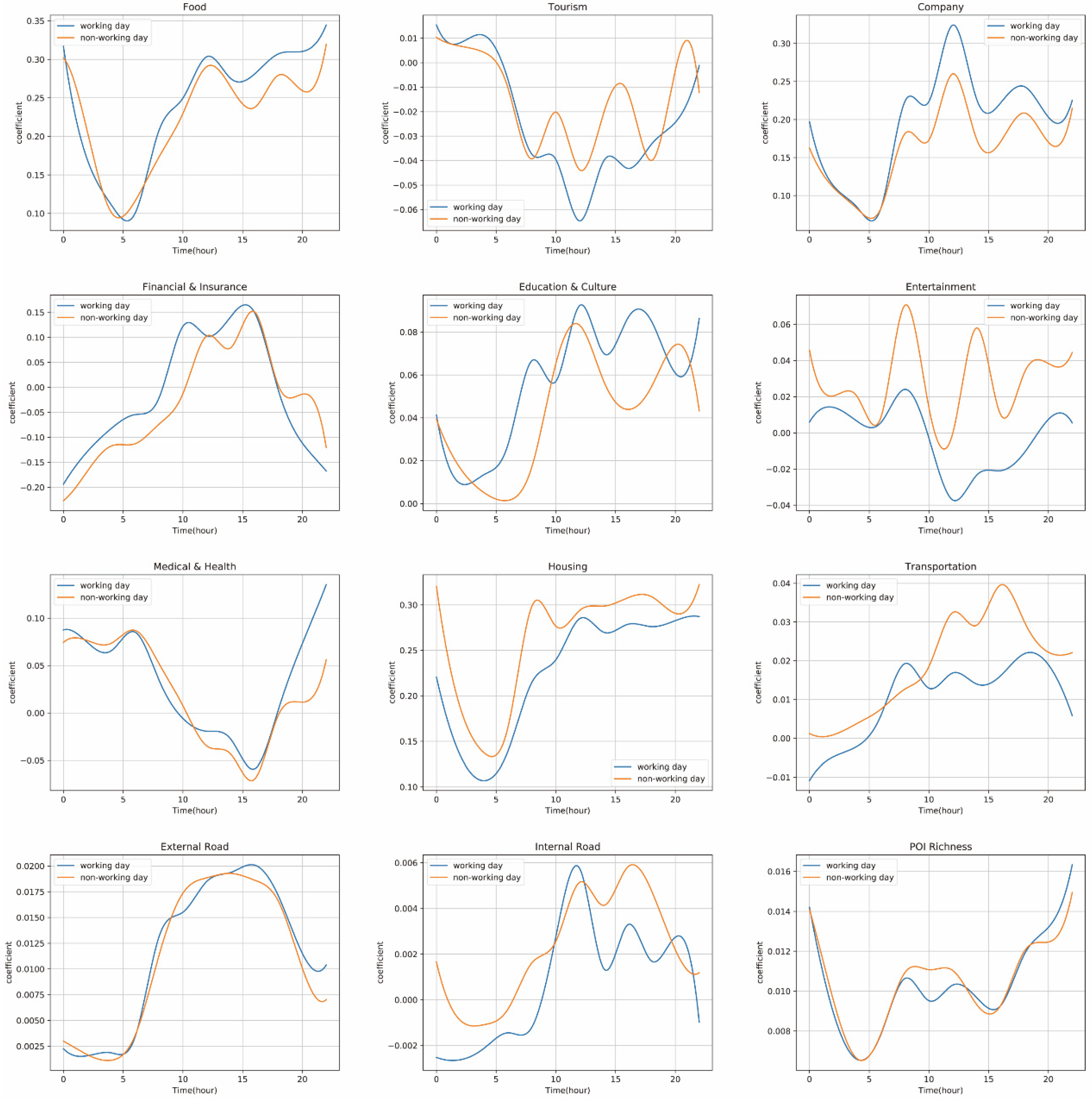
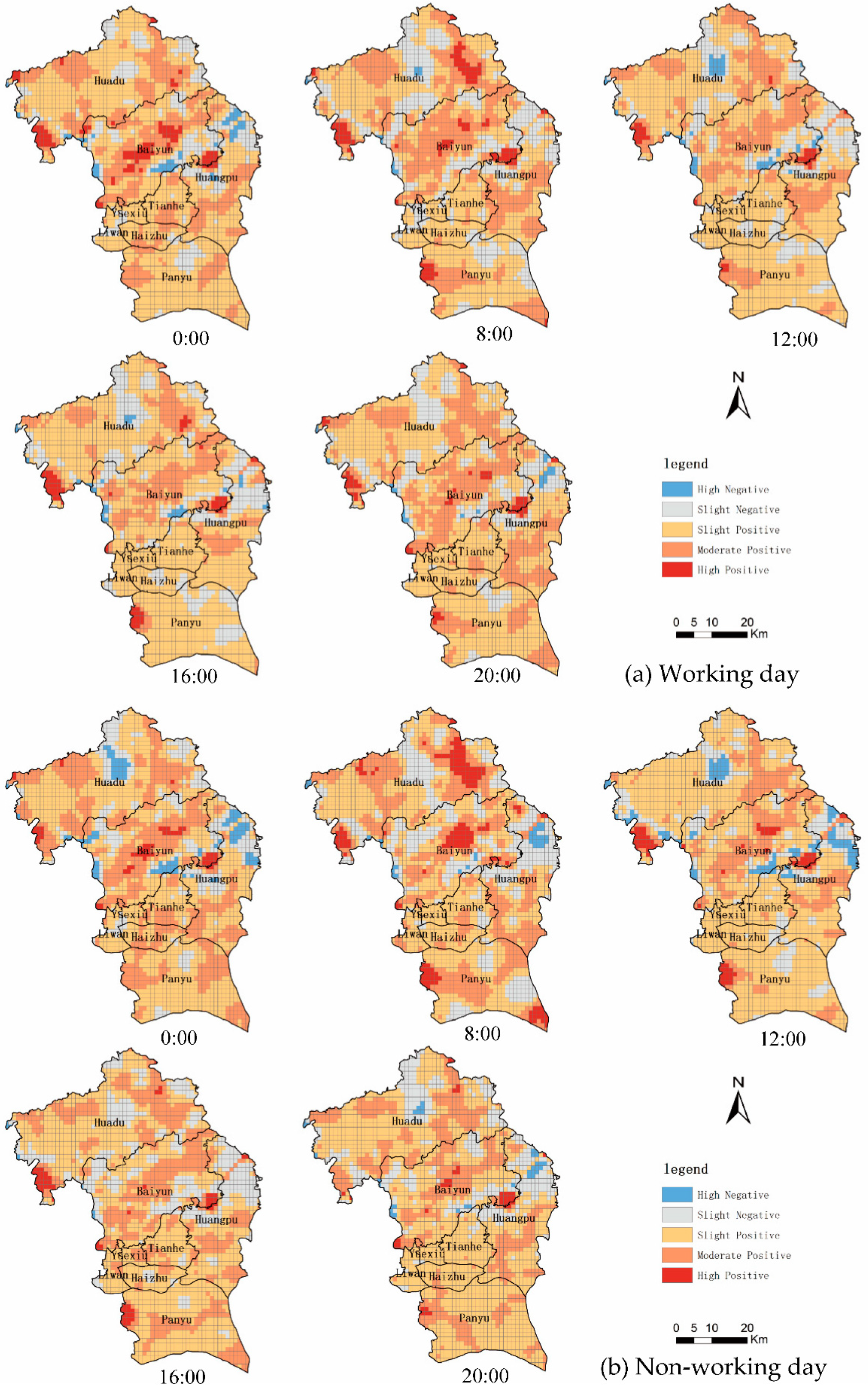
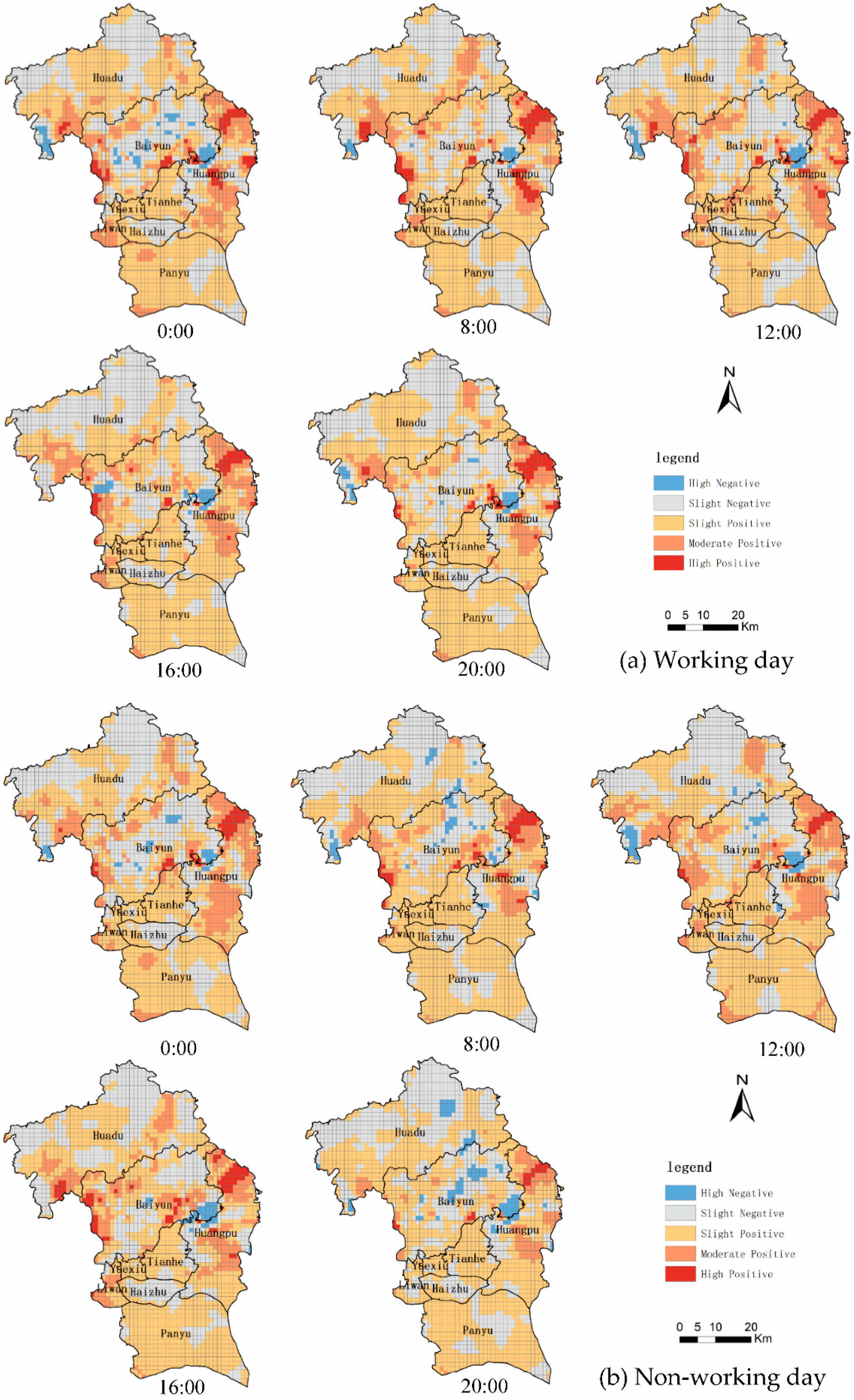
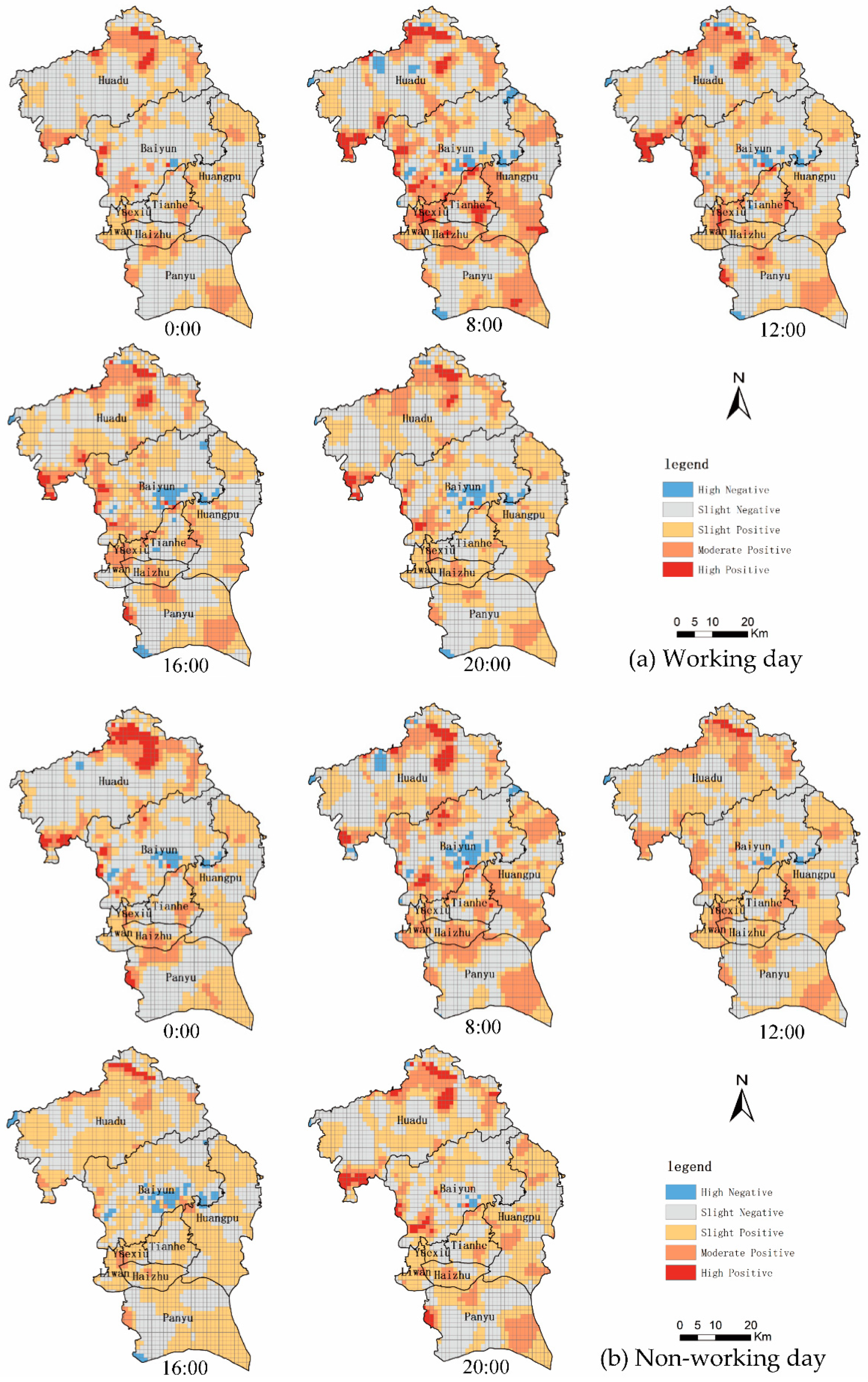
| Code | Variable | Mean | Standard Deviation |
|---|---|---|---|
| V1 | Number of food POIs | 0.0175 | 0.0649 |
| V2 | Number of tourism POIs | 0.0054 | 0.0313 |
| V3 | Number of company POIs | 0.0166 | 0.0598 |
| V4 | Number of financial and insurance POIs | 0.0047 | 0.0264 |
| V5 | Number of education and culture POIs | 0.013 | 0.0547 |
| V6 | Number of life service POIs | 0.0197 | 0.0735 |
| V7 | Number of entertainment POIs | 0.0208 | 0.0751 |
| V8 | Number of medical and health POIs | 0.0083 | 0.0334 |
| V9 | Number of housing POIs | 0.0072 | 0.0301 |
| V10 | Number of transportation POIs | 0.0241 | 0.0786 |
| V11 | External road density | 0.0614 | 0.0943 |
| V12 | Internal road density | 0.0402 | 0.0849 |
| V13 | Richness of POIs | 0.2348 | 0.2923 |
| Period | R2 | Adjusted R2 | Explanatory Variables | ||||||||||||
|---|---|---|---|---|---|---|---|---|---|---|---|---|---|---|---|
| Intercept | V1 | V2 | V3 | V4 | V5 | V7 | V8 | V9 | V10 | V11 | V12 | V13 | |||
| H0 | 0.853 | 0.852 | −6.8 × 10(−4) ** | 0.438 *** | −0.02 ** | 0.227 *** | −0.473 *** | −0.013 | 0.024 *** | 0.083 *** | 0.061 *** | 0.019 *** | −0.007 | 0.019 *** | 0.016 *** |
| H1 | 0.844 | 0843 | −3.1 × 10(−4) | 0.329 *** | −0.012 * | 0.177 *** | −0.358 *** | −0.006 | 0.024 *** | 0.067 *** | 0.017 | 0.011 ** | −0.006 * | 0.012 *** | 0.011 *** |
| H2 | 0.836 | 0.835 | −1.6 × 10(−4) | 0.241 *** | −0.008 * | 0.132 *** | −0.266 *** | −0.009 ** | 0.02 *** | 0.061 *** | 0.009 | 0.012 *** | −0.005 * | 0.006 *** | 0.008 *** |
| H3 | 0.826 | 0.826 | −1.3 × 10(−4) | 0.181 *** | −0.006 | 0.105 *** | −0.217 *** | −0.008 ** | 0.017 *** | 0.059 *** | 0.01 | 0.01 *** | −0.004 * | 0.005 ** | 0.007 *** |
| H4 | 0.828 | 0.827 | −1.1 × 10(−4) | 0.154 *** | −0.007 * | 0.087 *** | −0.183 *** | −0.01 *** | 0.014 *** | 0.064 *** | 0.008 | 0.012 *** | −0.003 * | 0.003 ** | 0.006 *** |
| H5 | 0.831 | 0.831 | −1.3 × 10(−4) | 0.124 *** | −0.006 * | 0.077 *** | −0.161 *** | −0.008 ** | 0.013 *** | 0.071 *** | 0.01 * | 0.012 *** | −0.002 | 0.003 ** | 0.006 *** |
| H6 | 0.854 | 0.853 | −1.8 × 10(−4) | 0.134 *** | −0.005 | 0.08 *** | −0.175 *** | −0.004 | 0.013 *** | 0.092 *** | 0.016 *** | 0.023 *** | −0.002 | 0.004 ** | 0.009 *** |
| H7 | 0.887 | 0.887 | −4.3 × 10(−4) ** | 0.182 *** | −0.006 | 0.117 *** | −0.219 *** | 0.011 ** | 0.006 | 0.128 *** | 0.035 *** | 0.051 *** | 0.002 | 0.006 *** | 0.011 *** |
| H8 | 0.908 | 0.907 | 6.3 × 10(−4) *** | 0.215 *** | −0.011 * | 0.182 *** | −0.139 *** | 0.048 *** | −0.014 *** | 0.12 *** | 0.058 *** | 0.08 *** | 0.013 *** | 0.009 *** | 0.009 *** |
| H9 | 0.929 | 0.929 | −5.7 × 10(−4) ** | 0.201 *** | −0.002 | 0.225 *** | 0.059 *** | 0.054 *** | −0.01 ** | 0.086 *** | 0.065 *** | 0.078 *** | 0.013 *** | 0.012 *** | 0.008 *** |
| H10 | 0.931 | 0.931 | −5.7 × 10(−4) ** | 0.219 *** | 0.003 | 0.205 *** | 0.165 *** | 0.052 *** | 0.009 * | 0.07 *** | 0.058 *** | 0.072 *** | 0.016 *** | 0.015 *** | 0.007 *** |
| H11 | 0.93 | 0.93 | −3.2 × 10(−4) | 0.298 *** | 0.002 | 0.261 *** | 0.228 *** | 0.091 *** | 0.002 | 0.036 ** | 0.05 *** | 0.63 *** | 0.02 *** | 0.012 *** | 0.003 *** |
| H12 | 0.931 | 0.931 | −6 × 10(−4) * | 0.289 *** | −0.006 | 0.302 *** | 0.284 *** | 0.07 *** | −0.004 | 0.066 *** | 0.077 *** | 0.074 *** | 0.018 *** | 0.02 *** | 0.008 *** |
| H13 | 0.924 | 0.923 | −4 × 10(−4) | 0.316 *** | 0.001 | 0.273 *** | 0.129 *** | 0.07 *** | 0.042 *** | 0.041 *** | 0.046 *** | 0.063 *** | 0.017 *** | 0.018 *** | 0.005 *** |
| H14 | 0.919 | 0.919 | −5.2 × 10(−4) * | 0.285 *** | 0.023 *** | 0.24 *** | 0.18 *** | 0.051 *** | 0.047 *** | 0.017 | 0.044 *** | 0.064 *** | 0.024 *** | 0.017 *** | 0.003 *** |
| H15 | 0.926 | 0.926 | −2.2 × 10(−4) * | 0.251 *** | 0.024 *** | 0.244 *** | 0.208 *** | 0.047 *** | 0.041 *** | 0.042 *** | 0.056 *** | 0.073 *** | 0.024 *** | 0.018 *** | 0.002 ** |
| H16 | 0.928 | 0.928 | −5.3 × 10(−4) * | 0.262 *** | 0.019 *** | 0.236 *** | 0.156 *** | 0.065 *** | 0.033 *** | 0.062 *** | 0.058 *** | 0.069 *** | 0.025 *** | 0.019 *** | 0.03 *** |
| H17 | 0.927 | 0.927 | −5.9 × 10(−4) ** | 0.295 *** | 0.005 | 0.237 *** | 0.142 *** | 0.068 *** | 0.024 *** | 0.078 *** | 0.045 *** | 0.062 *** | 0.025 *** | 0.018 *** | 0.004 *** |
| H18 | 0.927 | 0.927 | −5.7 × 10(−4) * | 0.319 *** | −0.019 ** | 0.255 *** | 0.064 *** | 0.08 *** | 0.021 *** | 0.094 *** | 0.059 *** | 0.063 *** | 0.017 *** | 0.013 *** | 0.009 *** |
| H19 | 0.915 | 0.914 | −5.9 × 10(−4) ** | 0.364 *** | −0.016 ** | 0.208 *** | −0.022 * | 0.051 *** | 0.004 | 0.068 *** | 0.034 *** | 0.059 *** | 0.015 *** | 0.011 *** | 0.01 *** |
| H20 | 0.911 | 0.91 | −4.6 × 10(−4) * | 0.39 *** | −0.027 *** | 0.177 *** | −0.177 *** | 0.024 *** | −0.002 | 0.084 *** | 0.051 *** | 0.066 *** | 0.005 | 0.011 *** | 0.012 *** |
| H21 | 0.899 | 0.899 | −6.5 × 10(−4) ** | 0.405 *** | −0.022 *** | 0.17 *** | −0.271 *** | 0.022 *** | 0.014 ** | 0.093 *** | 0.049 *** | 0.064 *** | 0.004 | 0.011 *** | 0.016 *** |
| H22 | 0.884 | 0.883 | −9 × 10(−4) *** | 0.443 *** | −0.018 ** | 0.192 *** | −0.371 *** | 0.001 | 0.014 * | 0.12 *** | 0.074 *** | 0.055 *** | 0.003 | 0.015 *** | 0.02 *** |
| H23 | 0.865 | 0.864 | −9 × 10(−4) ** | 0.444 *** | −0.025 ** | 0.236 *** | −0.496 *** | 0.002 | 0.016 * | 0.133 *** | 0.081 *** | 0.042 *** | −0.003 | 0.019 *** | 0.019 *** |
| Period | R2 | Adjusted R2 | Explanatory Variables | |||||||||||||
|---|---|---|---|---|---|---|---|---|---|---|---|---|---|---|---|---|
| Intercept | V1 | V2 | V3 | V4 | V5 | V7 | V8 | V9 | V10 | V11 | V12 | V13 | ||||
| H0 | 0.861 | 0.861 | −6.1 × 10(−4) * | 0.45 *** | −0.022 ** | 0.222 *** | −0.45 *** | −0.003 | 0.021 *** | 0.078 *** | 0.049 *** | 0.02 *** | −0.005 | 0.016 *** | 0.016 *** | |
| H1 | 0.852 | 0851 | −3.1 × 10(−4) | 0.368 *** | −0.019 *** | 0.179 *** | −0.376 *** | −0.004 | 0.024 *** | 0.051 *** | 0.021 * | 0.019 *** | −0.008 ** | 0.012 *** | 0.012 *** | |
| H2 | 0.841 | 0.841 | −2.1 × 10(−4) | 0.279 *** | −0.012 * | 0.143 *** | −0.306 *** | −0.005 | 0.018 *** | 0.068 *** | 0.008 | 0.014 *** | −0.005 * | 0.006 ** | 0.009 *** | |
| H3 | 0.832 | 0.832 | −1.1 × 10(−4) | 0.196 *** | −0.008 * | 0.104 *** | −0.221 *** | −0.006 | 0.021 *** | 0.056 *** | 0.004 | 0.014 *** | −0.004 * | 0.003 * | 0.007 *** | |
| H4 | 0.831 | 0.83 | −1.1 × 10(−4) | 0.16 *** | −0.006 * | 0.089 *** | −0.193 *** | −0.01 *** | 0.013 *** | 0.061 *** | 0.009 | 0.012 *** | −0.003 * | 0.003 * | 0.007 *** | |
| H5 | 0.829 | 0.829 | −1.1 × 10(−4) | 0.135 *** | −0.005 | 0.081 *** | −0.174 *** | −0.007 ** | 0.013 *** | 0.066 *** | 0.01 * | 0.015 *** | −0.003 * | 0.002 * | 0.007 *** | |
| H6 | 0.847 | 0.847 | −2.1 × 10(−4) | 0.137 *** | −0.007 * | 0.083 *** | −0.187 *** | −0.007 * | 0.015 *** | 0.085 *** | 0.014 ** | 0.024 *** | −0.0001 | 0.003 * | 0.009 *** | |
| H7 | 0.875 | 0.874 | −4.3 × 10(−4) ** | 0.172 *** | −0.012 ** | 0.1 *** | −0.218 *** | 0.004 | 0.014 *** | 0.11 *** | 0.035 *** | 0.039 *** | 0.002 | 0.005 ** | 0.013 *** | |
| H8 | 0.903 | 0.902 | 1.5 × 10(−4) *** | 0.21 *** | −0.014 ** | 0.135 *** | −0.232 *** | 0.026 *** | 0.018 *** | 0.119 *** | 0.058 *** | 0.054 *** | 0.008 *** | 0.009 *** | 0.012 *** | |
| H9 | 0.917 | 0.917 | −1.7 × 10(−4) ** | 0.216 *** | −0.004 | 0.162 *** | −0.213 *** | 0.044 *** | 0.03 *** | 0.113 *** | 0.056 *** | 0.085 *** | 0.011 *** | 0.01 *** | 0.01 *** | |
| H10 | 0.923 | 0.923 | −1.8 × 10(−4) ** | 0.26 *** | 0.0004 | 0.168 *** | −0.171 *** | 0.071 *** | 0.038 *** | 0.096 *** | 0.057 *** | 0.077 *** | 0.016 *** | 0.011 *** | 0.008 *** | |
| H11 | 0.927 | 0.926 | −3.2 × 10(−4) | 0.338 *** | 0.006 | 0.186 *** | −0.06 *** | 0.073 *** | 0.027 *** | 0.068 ** | 0.053 *** | 0.088 *** | 0.018 *** | 0.013 *** | 0.005 *** | |
| H12 | 0.927 | 0.926 | −5 × 10(−4) * | 0.354 *** | −0.0007 | 0.235 *** | −0.104 *** | 0.077 *** | 0.034 *** | 0.074 *** | 0.059 *** | 0.084 *** | 0.02 *** | 0.019 *** | 0.007 *** | |
| H13 | 0.923 | 0.922 | −2.2 × 10(−4) * | 0.31 *** | 0.011 | 0.221 *** | −0.081 *** | 0.05 *** | 0.042 *** | 0.137 *** | 0.049 *** | 0.08 *** | 0.015 *** | 0.022 *** | 0.007 *** | |
| H14 | 0.915 | 0.915 | −4.3 × 10(−4) | 0.32 *** | 0.015 ** | 0.18 *** | −0.012 | 0.043 *** | 0.068 *** | 0.038 *** | 0.025 *** | 0.082 *** | 0.021 *** | 0.019 *** | 0.004 *** | |
| H15 | 0.916 | 0.916 | −2.1 × 10(−4) | 0.295 *** | 0.031 *** | 0.164 *** | −0.017 | 0.045 *** | 0.054 *** | 0.053 *** | 0.042 *** | 0.084 *** | 0.022 *** | 0.015 *** | 0.002 ** | |
| H16 | 0.915 | 0.915 | −4.9 × 10(−4) * | 0.306 *** | 0.026 *** | 0.18 *** | −0.006 | 0.038 *** | 0.045 *** | 0.081 *** | 0.03 *** | 0.07 *** | 0.022 *** | 0.019 *** | 0.004 *** | |
| H17 | 0.924 | 0.924 | −2.1 × 10(−4) | 0.343 *** | 0.025 *** | 0.158 *** | 0.009 | 0.062 *** | 0.053 *** | 0.0166 | 0.048 *** | 0.082 *** | 0.017 *** | 0.016 *** | 0.004 *** | |
| H18 | 0.923 | 0.923 | −2.1 × 10(−4) *** | 0.354 *** | −0.015 ** | 0.2 *** | −0.122 *** | 0.04 *** | 0.037 *** | 0.061 *** | 0.049 *** | 0.072 *** | 0.018 *** | 0.019 *** | 0.01 *** | |
| H19 | 0.924 | 0.924 | −4.9 × 10(−4) * | 0.418 *** | −0.009 | 0.163 *** | −0.166 * | 0.015 *** | 0.018 *** | 0.001 | 0.081 *** | 0.067 *** | 0.009 *** | 0.014 *** | 0.011 *** | |
| H20 | 0.908 | 0.908 | −4.6 × 10(−4) * | 0.37 *** | −0.009 | 0.144 *** | −0.211 *** | 0.007 | 0.028 *** | 0.09 *** | 0.053 *** | 0.046 *** | 0.005 | 0.009 *** | 0.015 *** | |
| H21 | 0.901 | 0.901 | −2.1 × 10(−4) * | 0.423 *** | −0.016 *** | 0.125 *** | −0.257 *** | 0.004 | 0.014 ** | 0.093 *** | 0.049 *** | 0.064 *** | 0.004 | 0.011 *** | 0.016 *** | |
| H22 | 0.885 | 0.885 | −2.5 × 10(−4) ** | 0.42 *** | −0.023 ** | 0.172 *** | −0.373 *** | −0.008 | 0.025 *** | 0.125 *** | 0.085 *** | 0.056 *** | 0.0005 | 0.014 *** | 0.02 *** | |
| H23 | 0.868 | 0.868 | −2.8 × 10(−4) ** | 0.457 *** | −0.037 *** | 0.206 *** | −0.44 *** | −0.01 | 0.025 * | 0.122 *** | 0.081 *** | 0.039 *** | −0.008 * | 0.015 *** | 0.02 *** | |
| Variable | Min | First Quartile | Median | Third Quartile | Max | SD | p-Value |
|---|---|---|---|---|---|---|---|
| V1 | −5.767 | 0.038 | 0.203 | 0.423 | 10.715 | 0.505 | 0.000 *** |
| V2 | −4.158 | −0.102 | −0.008 | 0.061 | 4.188 | 0.395 | 0.019 * |
| V3 | −10.515 | 0.043 | 0.169 | 0.336 | 3.762 | 0.422 | 0.000 *** |
| V4 | −16.377 | −0.486 | −0.063 | 0.294 | 28.838 | 1.374 | 0.000 *** |
| V5 | −4.502 | −0.073 | 0.039 | 0.202 | 2.696 | 0.366 | 0.000 *** |
| V7 | −21.389 | −0.106 | 0.015 | 0.151 | 14.116 | 0.892 | 0.000 *** |
| V8 | −7.801 | −0.155 | 0.072 | 0.287 | 6.212 | 0.604 | 0.000 *** |
| V9 | −27.114 | −0.106 | 0.131 | 0.494 | 17.956 | 0.963 | 0.000 *** |
| V10 | −2.677 | −0.043 | 0.003 | 0.063 | 1.791 | 0.142 | 0.000 *** |
| V11 | −0.653 | −0.001 | 0.007 | 0.023 | 0.501 | 0.05 | 0.000 *** |
| V12 | −0.462 | −0.009 | 0.001 | 0.011 | 0.456 | 0.044 | 0.000 *** |
| V13 | −0.136 | 0.001 | 0.006 | 0.016 | 0.227 | 0.018 | 0.000 *** |
| Variable | Min | First Quartile | Median | Third Quartile | Max | SD | p-Value |
|---|---|---|---|---|---|---|---|
| V1 | −6.7 | 0.039 | 0.208 | 0.418 | 8.507 | 0.481 | 0.000 *** |
| V2 | −4.07 | −0.105 | −0.009 | 0.066 | 3.919 | 0.386 | 0.015 * |
| V3 | −7.283 | 0.02 | 0.138 | 0.292 | 6.507 | 0.385 | 0.000 *** |
| V4 | −9.930 | −0.531 | −0.073 | 0.283 | 23.898 | 1.387 | 0.000 *** |
| V5 | −5.316 | −0.094 | 0.024 | 0.185 | 3.133 | 0.378 | 0.000 *** |
| V7 | −13.846 | −0.094 | 0.025 | 0.172 | 10.909 | 0.729 | 0.000 *** |
| V8 | −9.848 | −0.17 | 0.074 | 0.291 | 4.238 | 0.632 | 0.000 *** |
| V9 | −20.474 | −0.109 | 0.126 | 0.512 | 19.31 | 0.955 | 0.000 *** |
| V10 | −3.0 | −0.039 | 0.008 | 0.072 | 4.083 | 0.159 | 0.000 *** |
| V11 | −0.681 | −0.001 | 0.007 | 0.023 | 0.547 | 0.051 | 0.000 *** |
| V12 | −0.427 | −0.007 | 0.001 | 0.013 | 0.416 | 0.043 | 0.000 *** |
| V13 | −0.167 | 0.001 | 0.006 | 0.015 | 0.228 | 0.018 | 0.000 *** |
Publisher’s Note: MDPI stays neutral with regard to jurisdictional claims in published maps and institutional affiliations. |
© 2021 by the authors. Licensee MDPI, Basel, Switzerland. This article is an open access article distributed under the terms and conditions of the Creative Commons Attribution (CC BY) license (http://creativecommons.org/licenses/by/4.0/).
Share and Cite
Zhang, X.; Sun, Y.; Chan, T.O.; Huang, Y.; Zheng, A.; Liu, Z. Exploring Impact of Surrounding Service Facilities on Urban Vibrancy Using Tencent Location-Aware Data: A Case of Guangzhou. Sustainability 2021, 13, 444. https://doi.org/10.3390/su13020444
Zhang X, Sun Y, Chan TO, Huang Y, Zheng A, Liu Z. Exploring Impact of Surrounding Service Facilities on Urban Vibrancy Using Tencent Location-Aware Data: A Case of Guangzhou. Sustainability. 2021; 13(2):444. https://doi.org/10.3390/su13020444
Chicago/Turabian StyleZhang, Xucai, Yeran Sun, Ting On Chan, Ying Huang, Anyao Zheng, and Zhang Liu. 2021. "Exploring Impact of Surrounding Service Facilities on Urban Vibrancy Using Tencent Location-Aware Data: A Case of Guangzhou" Sustainability 13, no. 2: 444. https://doi.org/10.3390/su13020444
APA StyleZhang, X., Sun, Y., Chan, T. O., Huang, Y., Zheng, A., & Liu, Z. (2021). Exploring Impact of Surrounding Service Facilities on Urban Vibrancy Using Tencent Location-Aware Data: A Case of Guangzhou. Sustainability, 13(2), 444. https://doi.org/10.3390/su13020444







